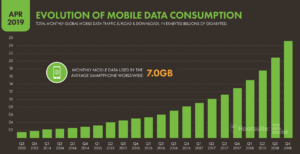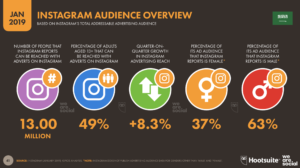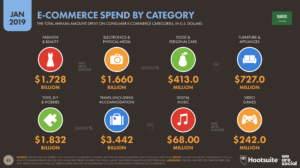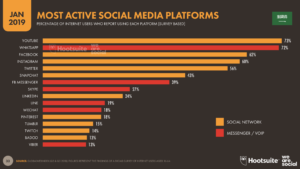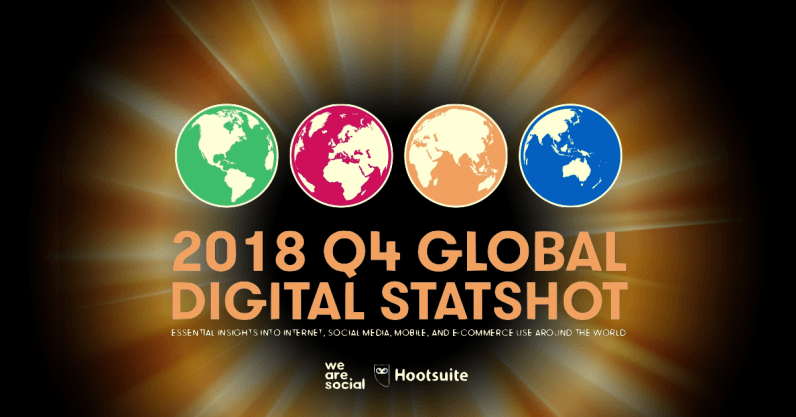The state of digital in April 2019: all the numbers you need, and a few big surprises
It’s only been three months since We Are Social published our first round of Digital 2019 reports, but our new Q2 Global Digital Statshot shows that the connected world has already changed considerably during that time.
For regional insights, see our analysis of Digital In Saudi Arabia.
Essential headlines

- Global internet users grew by 8.6 percent over the past twelve months, with 350 million new users contributing to an overall total of 4.437 billion by the start of April 2019.
- Social media user numbers have also registered solid growth, increasing by more than 200 million since this time last year to reach almost 3.5 billion by the time of publication. However, recent changes in Facebook’s reporting methodology mean that actual growth was probably even higher.
- There are now more than 5.1 billion people around the world using a mobile phone – a year-on-year increase of 2.7 percent – with smartphones accounting for more than two-thirds of all devices in use today.
- Roughly 98 percent of the world’s social media users – more than 3.4 billion people – access social platforms via mobile devices.
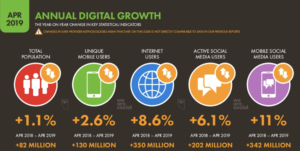
Internet use in April 2019
The latest reported figures suggest that an average of almost 1 million people came online for the first time each day over the past year, continuing the strong growth that we saw in our recent Digital 2019 reports.
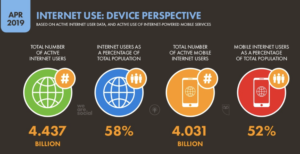
India accounted for the greatest share of growth in internet users in the first quarter of 2019, with data from the Telecom Regulatory Authority of India showing that the country added more than 44 million new internet subscribers in the first three months of the year.
CNNIC’s February 2019 report (in Mandarin) also shows meaningful growth in the number of internet users in China, with the total increasing by 29 million new users since the organisation’s previous report in August 2018.
The growing role of voice
GlobalWebIndex’s latest data show that more than 4 in 10 internet users made use of voice commands and voice search in the past 30 days, but that adoption of these tools varies considerably around the world.
Perhaps most tellingly, the use of voice is most common in India, China, and Indonesia – countries that already have some of the world’s largest internet populations, but that are also experiencing some of the greatest increases in new internet users.
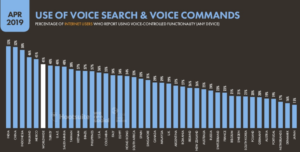
What’s more, despite Western media’s fixation on smart speakers like Amazon’s Echo devices, it’s important to stress that the majority of voice users are making use of voice functionality for everyday activities on their mobile phones.
This is particularly true of younger users, many of whom have not yet developed ‘fixed’ habits when it comes to using digital devices and services. Indeed, the latest data from GlobalWebIndex shows that almost half of all internet users aged 16 to 24 already use voice, compared to less than 30 percent of users aged 45 and above.
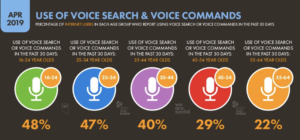
Social media use in April 2019
Almost 3.5 billion people around the world now use social media, with roughly 98 percent of them accessing social platforms via mobile devices.
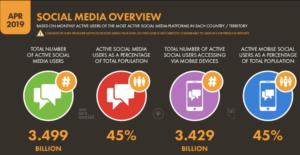
Overall, Facebook Inc.’s portfolio of services continues to dominate the global social landscape, while Tencent has further consolidated its lead position in Mainland China.
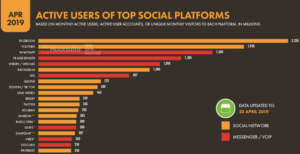
Exploring each platform’s latest advertising audience numbers offers another valuable perspective on social media use though, so let’s take a closer look at the key developments and trends in those numbers over the past three months.
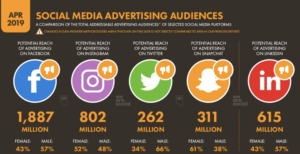
Facebook recently made some fundamental changes to the ways in which it reports advertising audience numbers across its various platforms so we can’t compare like-for-like growth trends this quarter. But the good news is that these changes let advertisers to build a clearer picture of the number of people they’re able to reach with ads on each of Facebook’s platforms.
The company’s Insights tools had previously been showing steady declines in users’ median number of ad clicks over the past three quarters, the latest data show much healthier figures.
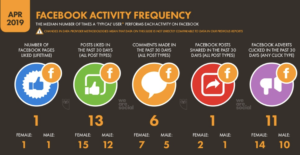
However, changes in audience definitions and reporting methodology mean that these figures can’t be compared on a like-for-like basis to previous reports, so these healthier figures do not necessarily mean that people have actually been clicking on more ads, nor can we be sure whether people have been sharing or commenting on Facebook posts more frequently.
Indeed, the latest insights from Locowise reveal that engagement with Facebook Page posts continues to decline, with the average post now garnering a response rate of just 3.6 percent – a relative drop of 3.4 percent in just the past three months.
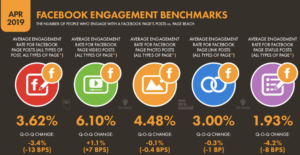
Meanwhile, organic reach for Facebook Page posts also continues its relentless downward trajectory, with Locowise reporting that barely 1 in 18 of a Page’s fans now see posts without paid media support – a relative decline of almost six percent in just the past three months.
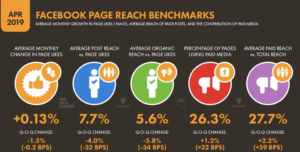
Facebook has made the same definition changes in its reporting of Instagram audiences, and – interestingly – this has resulted in similar patterns to those we saw above for Facebook.
Instagram announced that it had passed the billion active accounts milestone back in June 2018, but the latest figures in Facebook’s self-serve advertising tools suggest that the company only showed adverts to 802 million Instagram users in March 2019.
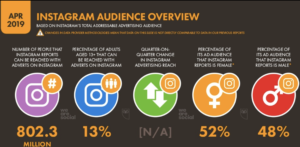
The advertising audience data that we collected prior to the recent change in Facebook’s audience definitions show that the number of Instagram users aged 13 to 17 fell by more than 3 percent between October 2018 to January 2019. All other age groups showed very healthy growth, and overall, the size of Instagram’s advertising audience actually increased by more than 4 percent during the same period (October 2018 to January 2019).
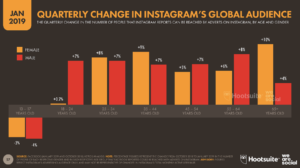
If Instagram is losing younger audiences, the big question is: where are they going? As usual, there’s plenty of speculation here, so let’s look at what the data tells us…
TikTok
In my recent conversations with senior marketers, journalists, and even the world’s biggest investors, it’s clear that many people believe TikTok is “the next big thing” in the world of social. And with the company already claiming more than 500 million active users – and more than a billion downloads – it’s easy to see why.
TikTok doesn’t publish audience figures to the same level as peers like Snapchat and Instagram though, so we need to look at some different data sources to get a sense of TikTok’s current status and growth.
A good place to start is Google Trends, which shows that worldwide interest in TikTok has grown significantly over the past year.
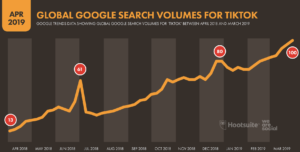
Google Trends data shows that worldwide interest in TikTok is already on a par with Snapchat (note that the TikTok trendline in the chart below also includes searches for “Tik Tok” – i.e. with a space – which appears to be a common variation in spelling for searches relating to the platform).

SensorTower reports that TikTok added 188 million new users in the first three months of this year, and the company ranks the app as the number one top performer in Apple’s iOS app stores for Q1 2019.
Meanwhile, App Annie reports that TikTok ranked fourth overall in the world’s most downloaded apps across iOS and Google Play stores for the whole of Q1.
That puts TikTok behind Facebook, Messenger, and WhatsApp, but ahead of Instagram:
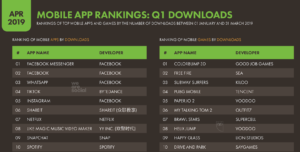
Snapchat
After a worrying start to the year, Snapchat saw some more reassuring trends in its advertising audience numbers this quarter, with the platform’s total addressable audience growing by 1.2 percent since January.
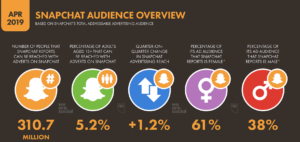
India accounted for almost a quarter of the growth in Snapchat’s audience over the past three months, and it also saw disproportionate growth in Russia this quarter, with the platform’s audience in the country up by almost eight percent in the past three months.
Interestingly, Snapchat’s self-serve advertising tools also report a slight increase in the size of the platform’s audience in the United States – a finding which seems to go against media speculation that the platform would see declines in its US user base this year.
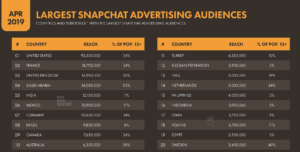
The data alone don’t reveal the cause of this reversal in Snapchat’s fortunes, but there’s a possibility that recent improvements to the platform’s Android app have revived interest amongst previously frustrated users.
The figures that Twitter publishes in its self-serve advertising tools tend to fluctuate significantly – even over short periods of time – which can make it trickier to identify precise trends for the platform.
However, the latest data suggest that Twitter also saw overall growth in its advertising audience in the first three months of 2019, with the global addressable audience up by 4.5 percent since January.
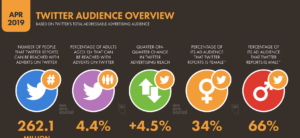
Twitter’s largest reported gains were in Russia, where the platform’s advertising audience grew by almost five times over the past three months, up from just over two million in January to almost 10 million at the time of writing.
Meanwhile, Twitter’s self-serve advertising tools also show an audience increase of almost 2.5 million in the United States, equating to quarter-on-quarter growth of more than five percent.
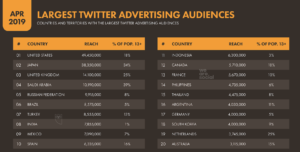
The world’s most active professional social network saw good growth again in the first quarter of 2019, with the platform’s self-serve advertising tools reporting an increase of 1.7 percent in its total addressable audience.
Advertisers can now reach almost 615 million people on LinkedIn, although it’s worth highlighting that these figures are based on registered users, rather than the monthly active user figures reported by most other platforms.
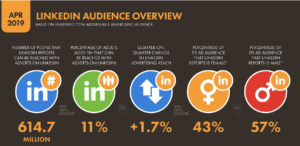
Interestingly, the quarter-on-quarter trends suggest that LinkedIn is growing fastest amongst the 18 to 24-year-old group, who now account for roughly 25 percent of the platform’s total advertising audience.

Discord
Discord is a new entrant to our ranking of the world’s most active social platforms, having recently exceeded a quarter of a billion active users.
Discord is a messaging platform that’s hugely popular with the world’s billion-plus online gamers, which should be more than enough reason for marketers need to add it to their list of potential opportunities.
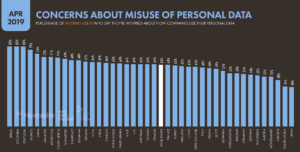
However, it’s Discord’s focus on communities that makes it particularly interesting as a platform, especially in a world where privacy concerns are increasingly important drivers of people’s social media preferences and behaviour.
If you’re new to Discord, or if you’d like a handy explainer, check out this great overview video from CNBC, complete with excellent stats and founder interviews:
Mobile use in April 2019
Our partners at GSMA Intelligence have revised their historical data for unique mobile users since January, but the worldwide total has since returned to the figure of 5.11 billion that we reported in our Digital 2019 report.
After the revisions, GSMA Intelligence reports that unique mobile users have grown by roughly 2.6 percent over the past twelve months, equating to an additional 130 million new mobile users since this time last year.
Note that we’ve changed the way we report mobile subscriptions too, and the 7.787 billion figure we’re quoting in this quarter’s report no longer includes IoT connections.
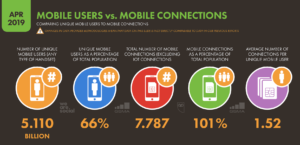
The latest data from Ericsson shows that smartphones now account for 68 percent of mobile connections, with feature phones’ share of connections dropping below 30 percent for the first time.
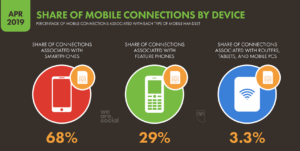
Meanwhile, Android has strengthened its control of the mobile market, with the latest data from Statcounter showing that the Alphabet-owned operating system accounted for more than three-quarters of all mobile handsets that access the web in March 2019.
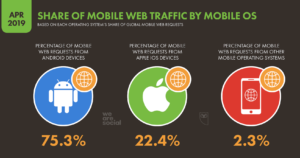
Our addiction to mobile data shows no signs of slowing either, with Ericsson reporting that monthly data consumption grew by an average of more than 4 billion gigabytes over the last quarter of 2018, to reach 25 exabytes per month.
